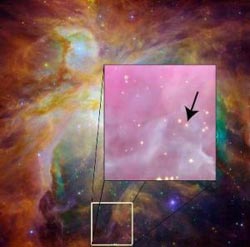
The arrow indicates the location of newly discovered twin stars in the Orion Nebula.(Photo: NASA / JPL, HST, David Jame
The newly discovered process of the youngest pair of twin stars revealed surprising differences in brightness, surface temperature and possibly the size of both.
The work, published in the June 19 issue of Nature, suggests that one of the two stars clearly formed before its twin. Because astrophysicists assume that twin stars form at the same time, this finding provides a new important test for the theory of successful star formation, forcing theorists to return to the body. Whether or not their model can produce pairs of stars formed at different times.
The twins were discovered in the Orion Nebula, a famous ' star nursery' , 1,500 light-years away. New stars form about 1 million years old. With a lifespan of about 50 billion years, they are equivalent to human 1-day-old children.

The arrow indicates the location of newly discovered twin stars in the Orion Nebula.(Photo: NASA / JPL, HST, David Jame
According to Keivan Stassun, astronomy lecturer at Vanderbilt University, 'These very young obscene couples are Rosetta stones. They tell us about the life history of newly formed stars. " You and Robert D. Mathieu, University of Wisconsin-Madison lead the project.
The obscure couple are pairs of stars that orbit an axis in an angle towards the earth. This direction allows astronomers to determine the speed of two orbiting stars around each other - even when they are unable to solve single stars - by measuring the periodic change of light that occurs when the stars move to opposite each other. With this information, astronomers can determine the mass of two stars by Newton's law of motion.
In this way, astronomers calculated that the newly discovered twins had almost the same mass and were 41% of the solar mass . According to current theories, mass and composition are two factors that determine the physical characteristics of a star and indicate its entire life cycle. Since both of these stars are clustered from the same cluster of gas and dust, they will have the same structure. With identical masses and components, they often have to be the same for all other aspects. So astronomers were surprised when they discovered the twins exhibited marked differences in brightness, surface temperature, and possibly size.
Astronomers made an initial calculation of the two stars' rotation by selecting for nearly 15 years of observing thousands of stars with a telescope at the Kitt Peak National Observatory, Arizona, SMARTS telescopes. at Cero Tololo Inter-American Observatory, Chile. To get more information about the two stars, they conducted further measurements with the Hobby Eberly Telescope, Texas.
By measuring the difference in light that is hidden throughout the orbit, astronomers can identify one of the brightest two-star stars and the brighter star with higher temperatures than the twin stars. degree. Further analysis of the light spectrum from the pair shows that one of the stars is about 10% larger than the other, but more observations are needed to confirm.
Stassun said, 'The easiest way to explain this difference is a star born about that star about 500,000 years ago. That period is equivalent to a half-day difference for people. '
In addition to making theorists verify the stellar model, new discoveries can make them correct their judgment about the mass and age of thousands of stars whose lifespan is less than a few million years. Current judgment is based on models with calculations for young stars that are thought to form at the same time. The necessary recalibration can be up to 20% of typical young star mass and 50% for small mass stars such as brown dwarfs.
Members of the research team include doctoral students Phillip Cargile and Alicia Aarnio, Vanderbilt University, Aaron Geller, University of Wisconsin-Madison and Eric Stempels, University of St. Louis. Andrew, Scotland.
The study is part of the Vanderbilt Initiative Data-Intensive Astrophysics program and support from the National Science Foundation and Research Corporation grants.